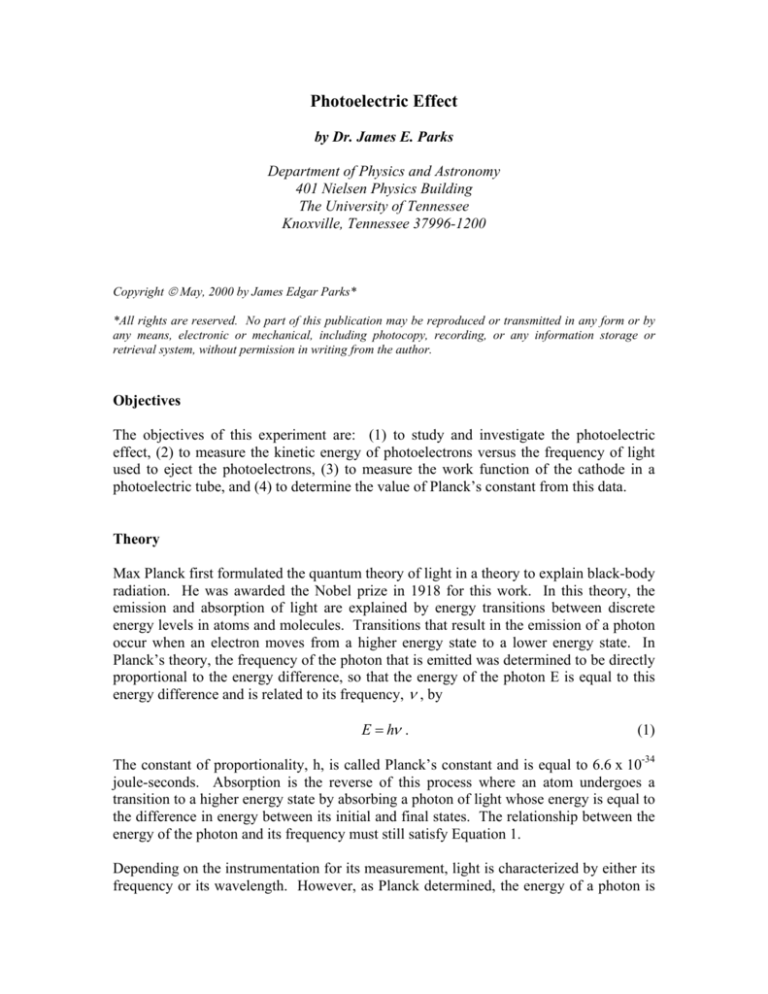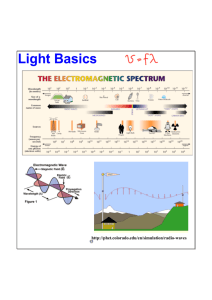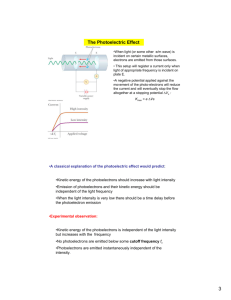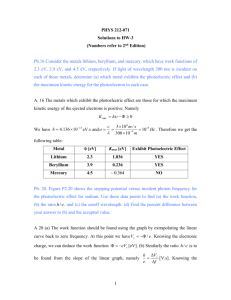
Photoelectric Effect
by Dr. James E. Parks
Department of Physics and Astronomy
401 Nielsen Physics Building
The University of Tennessee
Knoxville, Tennessee 37996-1200
Copyright © May, 2000 by James Edgar Parks*
*All rights are reserved. No part of this publication may be reproduced or transmitted in any form or by
any means, electronic or mechanical, including photocopy, recording, or any information storage or
retrieval system, without permission in writing from the author.
Objectives
The objectives of this experiment are: (1) to study and investigate the photoelectric
effect, (2) to measure the kinetic energy of photoelectrons versus the frequency of light
used to eject the photoelectrons, (3) to measure the work function of the cathode in a
photoelectric tube, and (4) to determine the value of Planck’s constant from this data.
Theory
Max Planck first formulated the quantum theory of light in a theory to explain black-body
radiation. He was awarded the Nobel prize in 1918 for this work. In this theory, the
emission and absorption of light are explained by energy transitions between discrete
energy levels in atoms and molecules. Transitions that result in the emission of a photon
occur when an electron moves from a higher energy state to a lower energy state. In
Planck’s theory, the frequency of the photon that is emitted was determined to be directly
proportional to the energy difference, so that the energy of the photon E is equal to this
energy difference and is related to its frequency, ν , by
E = hν .
(1)
The constant of proportionality, h, is called Planck’s constant and is equal to 6.6 x 10-34
joule-seconds. Absorption is the reverse of this process where an atom undergoes a
transition to a higher energy state by absorbing a photon of light whose energy is equal to
the difference in energy between its initial and final states. The relationship between the
energy of the photon and its frequency must still satisfy Equation 1.
Depending on the instrumentation for its measurement, light is characterized by either its
frequency or its wavelength. However, as Planck determined, the energy of a photon is
Photoelectric Effect
directly proportional to the frequency. The frequency and wavelength of photons of light
are related by the equations
c = νλ
c
λ=
ν
(2a)
(2b)
and
υ=
c
,
(2c)
λ
where c is the speed of light, 3 x 108 m/sec, ν is the frequency, and λ is the wavelength.
For photons of visible red light from a helium neon laser whose wavelength is 628 nm
(628 x 10-9 m) the frequency is 4.77 x 1014/sec.
Albert Einstein applied Planck’s radiation theory to explain the photoelectric effect where
photons of light incident on the surface of a material will cause electrons to be ejected. In
the photoelectric effect, the number of electrons emitted is found to increase
proportionately with the intensity. It was first thought that increasing the intensity of the
light, and hence the collective energy of all its photons, would increase the maximum
kinetic energy given to the ejected electrons, i.e., the more power, the greater the energy.
However, this was found not to be true. Increasing the intensity of the light was only
found to increase the number of electrons emitted, and to have no effect on their kinetic
energy.
Each electron ejected from the surface has a maximum kinetic energy that is directly
proportional to the frequency of the photon used to remove the electron from the surface.
However, the maximum kinetic energy of the electron is found to be less than the energy
of the photon as given by Equation 1. The difference between the photon energy given
by Equation 1 and the maximum kinetic energy of the ejected electron is found to be a
constant amount. In Einstein’s theory this difference is attributed to the binding energy
of the electron to the surface of the material. The binding energy is potential energy that
keeps the electron bound to the material. This energy is referred to as the work function
of the material, Wo, and is different for different materials. Once enough energy is
supplied to free the electron, the remaining energy supplied by the photon goes into
kinetic energy of the electron. Therefore, the total energy E supplied by the photon is hν
and is equal to the binding energy, Wo, plus the maximum kinetic energy of the electron,
KEmax or
E = hυ = Wo + KEmax
(3)
The kinetic energy of the photoelectron can be measured electronically as a function of
the frequency of light and can be graphed in a plot similar to Figure 1.
KEmax = hν − Wo
2
(4)
Photoelectric Effect
y = 0.4125x - 1.5
2.50E+00
2.00E+00
Kinetic Energy (eV)
1.50E+00
1.00E+00
5.00E-01
0.00E+00
0.00
-5.00E-01
2.00
4.00
6.00
8.00
10.00
-1.00E+00
-1.50E+00
-2.00E+00
Frequency (1 x 1014/sec)
Figure 1. Kinetic energy of electrons ejected by the photoelectric effect as a function of
the frequency of light.
In this experiment, KEmax will be measured for several frequency values using different
wavelengths of light generated from a mercury vapor lamp. Energy is measured in joules
in the international system of units, but it is often convenient to express energy in terms
of the energy given a single electron when it is accelerated through a potential difference
of 1 volt. This unit, called the electron volt, eV, is equal to 1.6 x 10-19 coulombs x 1 volt
or 1.6 x 10-19 Joules of energy, i.e.,
1eV=1.6×10-19 Joules
(5)
In this experiment, the kinetic energy of the electron is measured by the maximum
potential difference through which the electron has to move in order for it to come to rest.
That value can be converted to Joules by multiplying the potential difference (or voltage)
times the charge of the electron.
Assuming that Equation 4 is expressed in Joules, if the left side is divided by 1.6 x 10-19
coulombs, then
Vmax (eV ) =
KEmax ( Joules )
1.6 × 10−19 coulombs
(6)
and
⎡
⎤
Wo ( Joules )
h
.
ν (sec −1 ) −
Vmax (eV ) = ⎢
⎥
−19
1.6 × 10−19 (coulombs )
⎣1.6 × 10 (coulombs ) ⎦
3
(7)
Photoelectric Effect
Similarly, Wo can be expressed in electron volts also so that
Wo (eV ) =
Wo ( Joules )
1.6 × 10−19 coulombs
(8)
and
⎡
⎤
h
ν (sec−1 ) − Wo (eV ) .
Vmax (eV ) = ⎢
⎥
−19
⎣1.6 × 10 (coulombs ) ⎦
(9)
From Equation 9, then, if the maximum stopping potential for the ejected photoelectrons
is measured in volts as a function of the frequency, the slope of the straight line that
results will be equal to Planck’s constant divided by the charge of the electron. The
intercept for the stopping potential at zero frequency will produce the value for the work
function, Wo.
Apparatus and Principle of Its Operation
The equipment for this experiment includes: (1) a mercury light source, (2) a diffraction
grating with focusing lens on a mounting bracket, (3) a photoelectric head with a built-in
instrument amplifier with a high input impedance, (4) a set of yellow and green filters,
and (5) a digital voltmeter.
The apparatus is shown in Figure 2. The photoelectric head contains a phototube and a
built-in instrument amplifier with a high input impedance, >1013 ohms. The input of the
instrument amplifier has a small capacitance. The high input impedance allows charge to
collect on this capacitance with minimal leakage until a voltage is built up equal to the
kinetic energy of the photoelectrons ejected from the cathode of a phototube. This
voltage is called the stopping potential. Recall that electric potential in volts is defined as
energy in joules per unit charge in coulombs, or 1 volt is equal to 1 joule per coulomb.
Kinetic energy of the photoelectrons is measured in terms of electron volts, eV, equal to
the electron charge times 1 volt, i.e., 1.6 x 10-19 joules. The instrument amplifier has
unity gain, and its output voltage follows the input voltage. As a result, the instrument
amplifier allows the output voltage to be measured directly with a digital voltmeter. This
voltage is equal to the input voltage and the stopping potential.
Another way of understanding the unit is to consider that photoelectrons are ejected with
a kinetic energy allowing the electron charge to build up on the input of the amplifier
until enough potential energy is built up equal to the kinetic energy of the ejected
electrons. Once the potential reaches this value, no additional electrons will be collected,
because the potential would increase and repel any other electrons, pushing them back to
the surface of the cathode, their point of origination.
The light source for this apparatus consists of a mercury vapor lamp in a housing with a
power source. The mercury atom is excited to energy states that produce strong emission
lines at different colors shown in Table 1.
4
Photoelectric Effect
Table 1.
Color
Yellow
Green
Blue
Violet
Ultraviolet
Wavelength (nm)
578 & 580
546.074
435.835
404.656
365.48
Frequency (Hz)
5.18672 x 1014
5.48996 x 1014
6.87858 x 1014
7.40858 x 1014
8.20264 x 1014
Photons of light of one color emitted by the excited mercury atoms are separated from
other colors by a transmission grating that diffracts the light in different directions
according to their wavelength. A lens focuses the light onto the photodetector tube
located in a housing containing the instrument amplifier and battery power source.
Figure 2. Apparatus for photoelectric effect with close-up views of filter and phototube
mask behind fluorescent screen with entrance slit.
Procedure
1. In this experiment the kinetic energy of the photoelectrons is measured as a function
of the frequency of light from a mercury vapor light source. The apparatus should be
set up as is Figure 2. The light source should have a slit assembly mounted in place
with a lens/grating assembly attached by two rods. The grating should be mounted
away from the light source and should not be touched with fingers in making any
adjustments. The grating is blazed or constructed in such a way that the intensity of
5
Photoelectric Effect
the diffracted light is greater on one side than on the other. Turn on the mercury lamp
and let it warm up. The lamp should be left on at all times during the experiment
since it needs a warm-up time and a cool down time before it will come back on.
2. Use a card or piece of paper to observe the mercury lines from the source and
lens/grating assembly. Observe the diffracted spectral lines on both sides of the
central image and position the photoelectric head so that the more intense light
illuminates the phototube. (See Figure 3.)
Figure 3. Diffracted light from mercury light source on fluorescent screen showing
wavelengths (left to right) 580 nm, 545 nm, 436 nm, 405 nm, and 365 nm.
3. The photohead is mounted on a support base assembly so that it can be positioned at
the proper height and rotated about the lens/grating assembly, always at a fixed
distance away from the grating. The photohead has a white fluorescent screen on
which to image the mercury lines while adjusting the lens/grating assembly and
rotating the photohead into position. Adjust the lens/grating back and forth from the
light source to form the sharpest, best focused image on the fluorescent screen. Make
sure the photohead is at the proper height for the light to be centered on the slit in the
screen.
4. The head has a coupling tube between the entrance screen and the phototube that may
be rotated out of position so that the phototube can be observed. The phototube has a
mask with two aperture slots covering it. The mask prevents light from hitting the
center wire of the phototube, restricting it to the photocathode. Light passing through
the entrance slit of the focusing screen can be checked to make sure that it is incident
on the aperture of the mask and phototube. The head can be rotated about its
mounting post and because the fluorescent screen is out front, light passing through
its aperture may not necessarily pass through the apertures in the mask. Choose a line
to pass through the entrance screen and check to make sure that it also passes through
the phototube mask. If it doesn’t, rotate the photohead in its mounting post holder
and reposition the head until the chosen lines pass through both apertures.
5. Move the lens/grating assembly to produce the sharpest, best focused image onto the
mask of the phototube, since this is where the most light needs to be for the best
results. If necessary, repeat the alignment procedure above to make sure the light
passes through both apertures.
6
Photoelectric Effect
6. Make sure that the digital voltmeter is wired to the photohead and turn the power
switch on. Notice that a small voltage will start to build up on the voltmeter. The
photohead has a push-button switch to zero the charge collected on the input. Push
this button and observe the voltage on the voltmeter as it resets to zero. It is
important to zero the readings before collecting a new charge, particularly when a
charge is left on after a reading at a higher frequency light value.
7. Open up and prepare an Excel spreadsheet as in Table 1. Enter a formula to compute
the frequency of the different wavelengths to fill in the rest of the third column.
Table 2.
Color
Yellow
Green
Blue
Violet
Ultraviolet
Wavelength
(nm)
578
546
436
405
365
Frequency
X1014 Hz
5.186
Stopping Potential
(Volts)
8. Illuminate the phototube with the yellow line and make sure the apparatus is aligned
properly as outlined in the steps above. Observe the digital voltmeter reading and
push the “Push to Zero” button to discharge the unit. Hold the button in until the
reading is close to zero and release it while observing the voltage slowly build up
again. Note the value of the voltmeter reading. Place the yellow filter in front of the
fluorescent screen holding it in place with the magnetic strips. Again zero the reading
and let the unit build up its voltage. Note the new value for the stopping potential and
record it in your spreadsheet.
The yellow and green filters prevent ambient light from the overhead lights and or
the sun from reaching the phototube. The yellow and green lines are the least
energetic so that light from other sources will have their greatest interference at
these wavelengths. Also it is possible to get light of half these wavelengths from
the mercury source in the second order diffraction pattern overlapping the yellow
and green lines. Since these second order lines would have to be in the ultraviolet
for this to occur, those photons would be very energetic, and although few in
number, they would have a significant impact on the measurement. Be sure to use
the yellow and green filters when making the measurements with each of these
colors.
9. Adjust the apparatus and position the head to measure the stopping voltage for each
of the five wavelengths listed in Table 1. Make sure you use the proper filter with the
yellow and green lines. Record your data in your spreadsheet.
10. Prepare a graph of the stopping voltage versus the frequency of the light that is used.
Using the graphing tool, choose X-Y Scatter plot. Plot stopping voltage on the
vertical axis and frequency on the horizontal axis. Add a trendline and insert the
7
Photoelectric Effect
equation for the trendline onto your plot. Use the slope of your treadline to find
Planck’s constant and the intercept value to find the work function of the
photocathode material of the phototube. If there are data points that seem to deviate
to far from the treadline, repeat those measurements until you are satisfied that you
have done your best.
11. Repeat this experiment using lines from the second order pattern and the first order
lines on the side opposite the blazed side.
Questions
1. What effect do the neutral density filters have on the time needed for the voltmeter
needs to reach a steady state value? The apparatus includes a variable density
transmission filter that will decrease the intensity of the light when placed in the light
path. These filters do not affect the wavelength. They are computer-generated dot
and line patterns with clear space between them. The amount of transmitted light is
equal to the fraction of the total area covered by the dots and lines. The relative
transmission percentages are 100%, 80%, 60% 40%, and 20%.
2. If the time for reaching a steady value is very long, what effect might this have on the
measured stopping voltage values?
3. What would be the effect of two different wavelengths falling on the photocathode at
the same time?
4. Based on your value for the work function, what range of values might be expected
for energy levels in a solid of the same material as the photocathode? Would they be
negative or positive since bound states have negative energy values?
8







